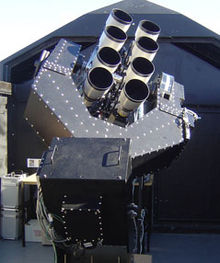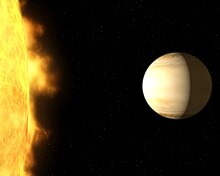WASP-5 is a magnitude 12 G-type main-sequence star located about 1,020 light-years away in the Phoenix constellation. The star is likely older than the Sun, slightly enriched in heavy elements and is rotating rapidly, being spun up by the tides raised by the giant planet on a close orbit.
WASP-16 is a magnitude 11 yellow dwarf main sequence star, with characteristics similar to the Sun, located in the Virgo constellation.
WASP-79b, also known as Pollera, is an extrasolar planet orbiting the star CD-30 1812. This planet is in the constellation Eridanus, and is about 810 light-years from Earth.
WASP-32 is a yellow main-sequence star in the constellation of Pisces. The star was given the formal name Parumleo in January 2020, Latin for small lion and referencing the national animal of Singapore.
WASP-26 is a yellow main sequence star in the constellation of Cetus.
WASP-25 is a yellow main sequence star in the constellation of Hydra.
WASP-50 is a G-type main-sequence star about 610 light-years away. The star is older than the Sun and slightly depleted in heavy elements compared to the Sun, and has a close to average starspot activity. Despite its advanced age, the star is rotating rapidly, being spun up by the tides raised by giant planet on close orbit.
WASP-189 b is an extrasolar planet that has an orbital period around its host star, WASP-189, of less than three earth days, and is about 322 light-years away in the Libra constellation. It was first discovered in 2018, and was observed in 2020 by CHEOPS.
WASP-78, is a single F-type main-sequence star about 2500 light-years away. It is likely to be younger than the Sun at 3.4+1.5
−0.8 billion years. WASP-78 is depleted in heavy elements, having a 45% concentration of iron compared to the Sun.
BD+00 316 is an ordinary star with a close-orbiting planetary companion in the equatorial constellation of Cetus. It is also known as WASP-71 since 2019; BD+00 316 is the stellar identifier from the Bonner Durchmusterung catalogue. With an apparent visual magnitude of 10.56, it is too faint to be visible to the naked eye. This star is located at a distance of 1,160 light-years based on parallax measurements, and is drifting further away with a heliocentric radial velocity of 7.7 km/s.
WASP-62, formally named Naledi, is a single star about 573 light-years away. It is an F class main-sequence star, orbited by a planet, WASP-62b. The age of WASP-62 is much younger than the Sun at 0.8±0.6 billion years, and it has a metal abundance similar to the Sun.
WASP-54, also known as BD+00 3088, is a binary star system about 825 light-years away. The primary, WASP-54A, is a F-type main-sequence star, accompanied by the red dwarf WASP-54B on a wide orbit. WASP-54 is depleted in heavy elements, having 55% of the solar abundance of iron. The age of WASP-54 is slightly older than the Sun's at 6.9+1.0
−1.9 billion years.
WASP-84, also known as BD+02 2056, is a G-type main-sequence star 327 light-years away in the constellation Hydra. Its surface temperature is 5350±31 K and is slightly enriched in heavy elements compared to the Sun, with a metallicity Fe/H index of 0.05±0.02. It is rich in carbon and depleted of oxygen. WASP-84's age is probably older than the Sun at 8.5+4.1
−5.5 billion years. The star appears to have an anomalously small radius, which can be explained by the unusually high helium fraction or by it being very young.
The Qatar Exoplanet Survey, also known as QES, is an international exoplanet search survey based in Qatar. Its main goal is to detect exoplanets using the transit method, which is observing the light curve of the host star.
WASP-80 is a K-type main-sequence star about 162 light-years away. The star's age is much younger than the Sun's at 1.352±0.222 billion years. WASP-80 is similar to the Sun in concentration of heavy elements, although this measurement is highly uncertain.

WASP-96b is a gas giant exoplanet. Its mass is 0.48 times that of Jupiter. It is 0.0453 AU from the class G star WASP-96, which it orbits every 3.4 days. It is about 1,140 light-years away from Earth, in the constellation Phoenix. It was discovered in 2013 by the Wide Angle Search for Planets (WASP).




